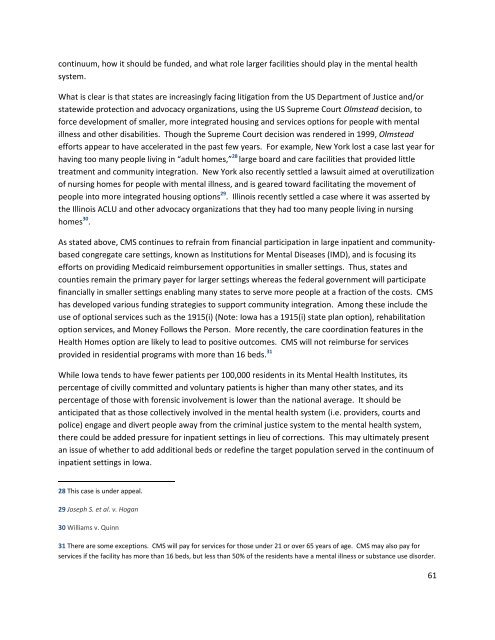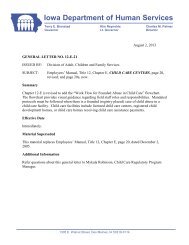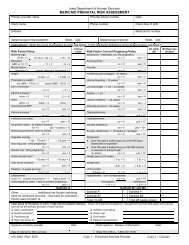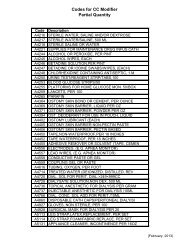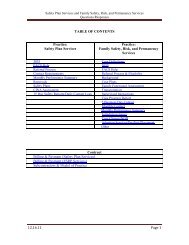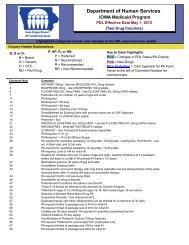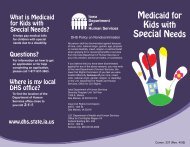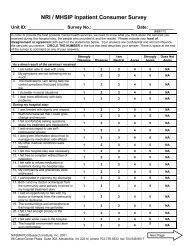Iowa Mental Health and Disability Services System Redesign Interim ...
Iowa Mental Health and Disability Services System Redesign Interim ...
Iowa Mental Health and Disability Services System Redesign Interim ...
- No tags were found...
You also want an ePaper? Increase the reach of your titles
YUMPU automatically turns print PDFs into web optimized ePapers that Google loves.
continuum, how it should be funded, <strong>and</strong> what role larger facilities should play in the mental health<br />
system.<br />
What is clear is that states are increasingly facing litigation from the US Department of Justice <strong>and</strong>/or<br />
statewide protection <strong>and</strong> advocacy organizations, using the US Supreme Court Olmstead decision, to<br />
force development of smaller, more integrated housing <strong>and</strong> services options for people with mental<br />
illness <strong>and</strong> other disabilities. Though the Supreme Court decision was rendered in 1999, Olmstead<br />
efforts appear to have accelerated in the past few years. For example, New York lost a case last year for<br />
having too many people living in “adult homes,” 28 large board <strong>and</strong> care facilities that provided little<br />
treatment <strong>and</strong> community integration. New York also recently settled a lawsuit aimed at overutilization<br />
of nursing homes for people with mental illness, <strong>and</strong> is geared toward facilitating the movement of<br />
people into more integrated housing options 29 . Illinois recently settled a case where it was asserted by<br />
the Illinois ACLU <strong>and</strong> other advocacy organizations that they had too many people living in nursing<br />
homes 30 .<br />
As stated above, CMS continues to refrain from financial participation in large inpatient <strong>and</strong> communitybased<br />
congregate care settings, known as Institutions for <strong>Mental</strong> Diseases (IMD), <strong>and</strong> is focusing its<br />
efforts on providing Medicaid reimbursement opportunities in smaller settings. Thus, states <strong>and</strong><br />
counties remain the primary payer for larger settings whereas the federal government will participate<br />
financially in smaller settings enabling many states to serve more people at a fraction of the costs. CMS<br />
has developed various funding strategies to support community integration. Among these include the<br />
use of optional services such as the 1915(i) (Note: <strong>Iowa</strong> has a 1915(i) state plan option), rehabilitation<br />
option services, <strong>and</strong> Money Follows the Person. More recently, the care coordination features in the<br />
<strong>Health</strong> Homes option are likely to lead to positive outcomes. CMS will not reimburse for services<br />
provided in residential programs with more than 16 beds. 31<br />
While <strong>Iowa</strong> tends to have fewer patients per 100,000 residents in its <strong>Mental</strong> <strong>Health</strong> Institutes, its<br />
percentage of civilly committed <strong>and</strong> voluntary patients is higher than many other states, <strong>and</strong> its<br />
percentage of those with forensic involvement is lower than the national average. It should be<br />
anticipated that as those collectively involved in the mental health system (i.e. providers, courts <strong>and</strong><br />
police) engage <strong>and</strong> divert people away from the criminal justice system to the mental health system,<br />
there could be added pressure for inpatient settings in lieu of corrections. This may ultimately present<br />
an issue of whether to add additional beds or redefine the target population served in the continuum of<br />
inpatient settings in <strong>Iowa</strong>.<br />
28 This case is under appeal.<br />
29 Joseph S. et al. v. Hogan<br />
30 Williams v. Quinn<br />
31 There are some exceptions. CMS will pay for services for those under 21 or over 65 years of age. CMS may also pay for<br />
services if the facility has more than 16 beds, but less than 50% of the residents have a mental illness or substance use disorder.<br />
61


